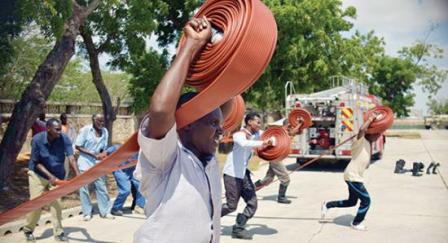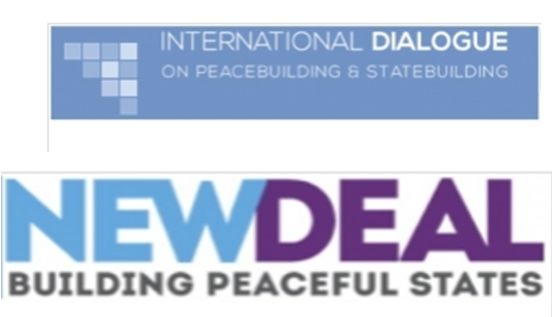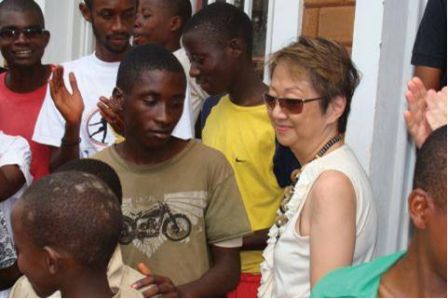Uprooting the causes of conflicts
Momentum in post-conflict peacebuilding in Africa
On 11 July 2011, when South Sudan’s President Salva Kiir and his 8.3 million compatriots celebrated the new country’s first independence, he was careful to remind everyone of the harsh realities on the horizon. “All the indices of human welfare put us at the bottom of all humanity,” he said, adding: “All citizens of this nation must therefore fully dedicate their energies and resources to the construction of a vibrant economy.” Not surprisingly, President Kiir’s note of caution was easily drowned in a sea of high expectations and hopes for a peaceful, democratic and prosperous nation.
No quick fixes
Two years later, South Sudanese people realize that there are no shortcuts to building a nation. Peace is still elusive as fighting continues on many fronts, corruption is creeping into public offices and unemployment is still high. Even with abundant oil and a fertile land, the pace of development is slow, albeit steady.
Barely a month after independence, the Lou Nuer and Murle people in the Jonglei and Warrap states in the eastern part of South Sudan fought over cattle, leaving about 600 people dead. Already an estimated 2.5 million people have lost their lives over the two decades of war between Sudan and South Sudan, according to Human Rights Watch, a New York–based advocacy group.
Yet both countries still squabble over oil proceeds. South Sudan shut down oil production in January 2012, accusing Sudan of confiscating oil flowing through its pipelines and of overcharging on handling fees. Since oil accounts for 80% of South Sudan’s gross domestic product (GDP), that move virtually cut off its economy’s arteries. The frosty relationship between the two countries, caused largely by disputes over oil, threatens “the very foundation on which South Sudan’s future will be built,” says The Telegraph, a British newspaper. Following the oil shutdown, South Sudan’s economy contracted by 11% by the end of 2012, according to the International Monetary Fund (IMF).
No doubt the South Sudanese government must rebuild its financial, social and security institutions from the ground up, while also keeping an eye on reconciling the feuding ethnic groups and tackling corruption. In May 2012, angered by the alleged looting of a staggering $4 billion from state coffers, President Kiir warned government officials, “We fought for freedom, justice and equality, yet once we got to power, we forgot what we fought for and began to enrich ourselves at the expense of the people.”
Nonetheless, the socioeconomic and security conditions in South Sudan are now better than they were at independence. There is the $718 million multi-donor trust fund in addition to a $130 million loan from the World Bank’s International Development Association that have helped build 87 hospitals and clinics and 336 primary classrooms, among other things. “Over 108 women’s groups have been provided with funds for economic activities like tailoring, food processing and running retail stores,” says Mary Jervas Yak, South Sudan’s deputy minister for finance.
Peacekeeping to peacebuilding
Peacebuilding is the last but most critical stage in a conflict resolution process, according to a 1992 United Nations Secretary-General’s report titled Agenda for Peace, Preventive Diplomacy and Peacemaking. That process begins when preventive diplomacy fails and peacemaking is needed to get warring factions to agree to a negotiated settlement. This leads to peacekeeping, which includes disarming combatants and monitoring how the peace agreement is implemented. The last stage involves peacebuilding activities, which build and support institutions intended to solidify peace, states the UN report.
Given the high expectations and many challenges in post-conflict countries, the transition from peacekeeping to peacebuilding can be difficult, notes Michael von der Schulenburg. He is one of the UN mission chiefs whose successful management of peacebuilding operations in Sierra Leone following the end of a brutal conflict in 2002 is hailed as a shining example. In that country, the UN peacebuilding assistance programme supported the integration into society of some 45,000 former combatants, collected remnants of small arms through a community-based programme and strengthened the capacity of the government and civil society. The programme also provided assistance with holding elections in 2007 and 2012.
In a nutshell, adds Mr. von der Schulenburg, “Peacebuilding is access to water, to education, to basic health care—access to opportunities” (see Africa Renewal, August 2011). Although Sierra Leone still grapples with youth unemployment, corruption and other governance issues, economic growth is currently a massive 17%, according to the IMF, and agricultural production is on an upswing, notes the World Bank.
The Sierra Leonean model
To a large extent, neighbouring Liberia has followed the Sierra Leonean peacebuilding model. But Sierra Leone had to deal with only 45,000 ex-combatants, while Liberia has more than 100,000. Providing sustainable jobs to the ex-combatants has been more difficult in Liberia than it was in Sierra Leone, as Liberian former fighters appear to be more restive. In 2010, for example, the UN mission in Liberia announced that about 2,000 mostly jobless Liberian fighters had moved over to western Côte d’Ivoire to fight alongside anti-government forces in that country.
The UN is convinced that reconciliation is an important part of post-conflict peacebuilding. Sierra Leone’s reconciliation efforts were based on “peace with justice,” which, as part of the healing process, encouraged the formation of a Truth and Reconciliation Commission (TRC). Here people could voluntarily reveal wrongdoings they had committed during the war and seek forgiveness. The TRC was bolstered by a UN-supported Special Court to try those who had committed serious crimes. Key figures such as Foday Sankoh, the leader of the rebel Revolutionary United Front, and Hinga Norman, who led a pro-government militia, were indicted but the two died in custody during trials.
Liberia took a different approach and its reconciliation efforts have stumbled a few times. Despite agitation by some citizens, the country saw no need for a special court. In 2005, however, it set up a TRC, which in 2009 submitted a report in which it blacklisted current president Ellen Johnson-Sirleaf and 49 others, saying they were to be “specifically barred from holding public offices; elected or appointed for a period of 30 years.” The Supreme Court declared that recommendation unconstitutional.
Liberia’s reconciliation challenge
After acrimonious elections in October 2011, President Ellen Johnson-Sirleaf appointed fellow Nobel laureate Leyman Gbowee to lead reconciliation efforts. Ms. Gbowee resigned after less than a year in office, claiming the president wasn’t serious enough about reconciliation. George Opong Weah, a former soccer star who has lost two presidential elections to Johnson-Sirleaf, succeeded Ms. Gbowee. Since his appointment, Mr. Weah has been relatively quiet, many say.
Even with these challenges, at a 7.5% growth rate, the Liberian economy is scoring impressive gains. The UN has a huge peace operation in the country, training up to 4,000 police personnel, supporting the judicial system and extending government’s presence to far-flung towns and villages. And recently, for the first time in decades, a contingent of Liberian soldiers joined the UN peacekeeping mission in Mali, a fellow West African country now mired in conflict.
Peacebuilding is necessary to “reduce a country’s risk of lapsing or relapsing into conflict,” says Charles Dambach, the former chief executive officer of Alliance for Peacebuilding, a Washington DC–based organization that promotes peacebuilding. He agrees that “the ultimate objective of peacebuilding is to reduce and eliminate the frequency and severity of violent conflicts.”
Jobs problems in Côte d’Ivoire
Similar peacebuilding projects are also under way in many other African countries, such as Burundi, Côte d’Ivoire, the Democratic Republic of the Congo (DRC) and Guinea-Bissau, all aimed at dealing with the root causes of conflict. Adama Bamba, coordinator of Côte d’Ivoire’s Emergency Youth Employment and Skills Development Project, says that jobless youths were the most active group in his country during the war. Up to 60% of those between the ages of 14 and 35 have no jobs, according to Côte d’Ivoire’s National Institute of Statistics. Despite this, the country is still the world’s largest cocoa producer.
With help from the World Bank, Côte d’Ivoire is now moving aggressively to create jobs. For example, it has enlisted the private sector to train more than 3,000 youths, many of whom are employed by these companies.
In 2008, UN Secretary-General Ban Ki-moon announced that Côte d’Ivoire was eligible to receive money from the global body’s Peacebuilding Fund, which was set up in 2006 to support countries emerging from conflict. The fund doled out $18 million to assist Côte d’Ivoire in land reforms, security and activities designed to extend state authority to areas where it had ceased to exist.
The litmus test
The Great Lakes region—made up of Burundi, the DRC, Kenya, Rwanda, Tanzania and Uganda—presents a litmus test on peacebuilding. Last May, both Mr. Ban and Jim Yong Kim, the World Bank president, visited the region. Earlier, Mr. Ban had been in Mozambique, where he had touted the country’s development efforts. “Mozambique, Rwanda and Uganda have all shown that it is possible to recover from conflict and progress towards the MDGs [Millennium Development Goals],” he said while in Mozambique. “It is now time for the DRC to follow their example.”
The DRC’s development indicators are not stellar, which is why both Mr. Ban and Mr. Kim want changes immediately. Up to 70% of its people live on less than $1.25 per day. Among other woes facing the country, are a crumbling infrastructure and 2.4 million severely malnourished children.
Burundi’s struggles
Since 2003, when the UN stepped up its peacekeeping mission in Burundi, the guns have mostly fallen silent. However, 10 years later, Burundi is still one of the world’s poorest countries, ranking 178 out of 186 in the 2013 UN Development Programme’s human development index, which rates countries based on life expectancy, education and incomes. Burundi’s peacebuilding efforts haven’t quite been on the same level as those of Liberia and Sierra Leone. But this landlocked country has stabilised politically, while increased investments in agriculture—particularly coffee, its mainstay—are expected to improve living conditions.
Already, massive road projects have created thousands of jobs and life expectancy has risen from 43 years in 2000 to 50 years in 2011, says the World Bank. While Burundi will likely not meet the MDG targets, it has moved in the right direction by reforming state institutions and providing social services for its people, notes the bank.
Overall, post-conflict African countries are trying hard to deliver peace dividends—jobs, peace, freedom, democracy and the rule of law. Mr. Ban’s assessment is upbeat: “Throughout Africa, we see growth. Economies are growing. Freedom and good governance are growing. Confidence is growing.” With peacebuilding, Africa may have found the right formula for rooting out conflicts. The challenge is to make it last.
By: Kingsley Ighobor, courtesty of Africa Renewal
Stay with Sierra Express Media, for your trusted place in news!
© 2013, https:. All rights reserved.





